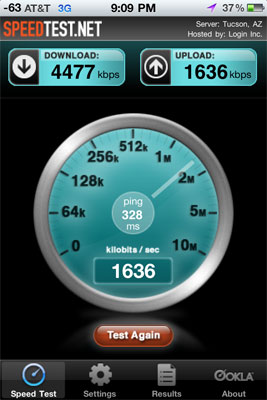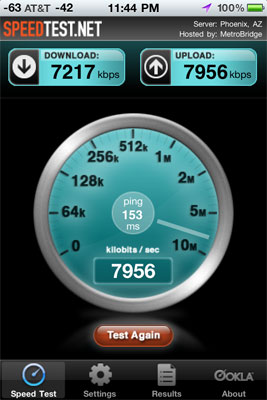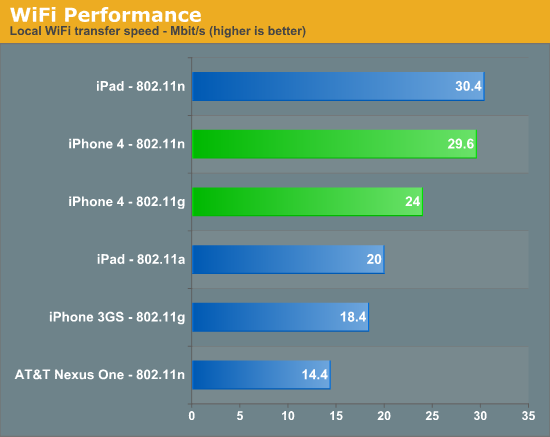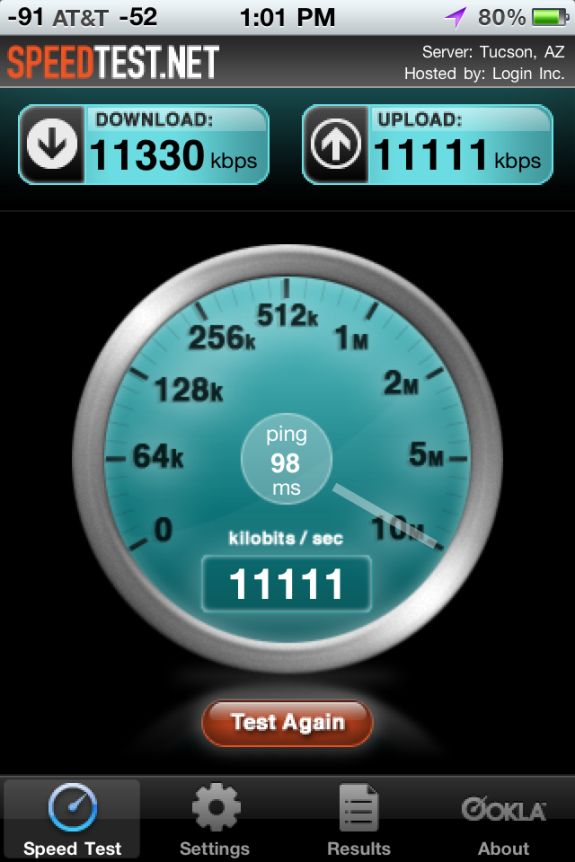Apple's iPhone 4: Thoroughly Reviewed
by Brian Klug & Anand Lal Shimpi on June 30, 2010 4:06 AM EST- Posted in
- Smartphones
- Apple
- iPhone 4
- Gadgets
- Mobile
Network Improvements
The iPhone continues to be an AT&T exclusive in the US. With the iOS 4 upgrades the iPhone 4 supports tethering over Bluetooth or USB. The feature is an extra $20 per month on top of your existing iPhone data plan and it also deducts bandwidth from the 2GB you get with the data plan. It's not a coincidence that AT&T timed the release of its iPhone tethering option with the move away from unlimited data plans. You don't have to give up your existing unlimited data plan if you don't want to, however if you want to enable tethering you have to sign up for the new $25/2GB plan.
I'm not a huge fan of iPhone tethering right now because despite paying for the service and having full signal strength on AT&T, I'm getting horrible transfer rates while trying to upload this article. I had to sign up for airport WiFi to get it live, thanks AT&T. When it does work however, it works well. As you'll see later you can easily get multiple Mbps out of AT&T's network in areas with good coverage. That easily equals the lower end of what you'd see from WiMAX today. As I've mentioned before however, it's really hit or miss with AT&T. The network is either great or totally unusable, while its competitors are generally more consistent but never quite as fast. I'd say that there's a good chance Apple will bring the iPhone to Verizon, it's just a matter of when.
| Cost of Ownership Comparison | |||||
| AT&T iPhone 4 | Sprint EVO 4G | Verizon HTC Droid Incredible | |||
| Cost of Device | $199 w/ 2 year contract | $199 w/ 2 year contract after $100 MIR | $199 w/ 2 year contract | ||
| Plan with 900 Minutes, Unlimited SMS/Data | $104.99/mo, unlimited SMS, 2GB data | $99.99/mo, unlimited SMS, unlimited data, 4G | $109.98/mo, unlimited SMS, unlimited data | ||
| Tethering | + $20/mo | + $29.99/mo | + $25/mo* | ||
| Total Monthly + Tethering | $124.99/mo | $129.98/mo | $134.98/mo | ||
| Total Cost of Ownership over 2 Years | $2718.76 | $2598.76 after $100 MIR | $2838.52 | ||
| Total Cost of Ownership over 2 Years w/ Tethering | $3198.76 | $3318.52 after $100 MIR | $3438.52 | ||
AT&T's plans are actually reasonably priced if you don't go over the data limits. A $15/mo data plan will get you 200MB of transfers per month and $25 will give you 2GB. For users like my parents the 200MB option is great. Even for me personally, 2GB is fine. I tend to peak at 700MB per month, but that's because at the office I'm almost always on my desktop or connected via WiFi. It's unclear how tethering is going to change this for me. Our own Brian Klug on the other hand easily pushes more than 2GB of transfers per month. So AT&T's rate switch is either going to save you a few bucks per month or make you really unhappy.
The iPhone 4 brings HSUPA class 6 for upload speeds of up to 5.76 megabits/s to the platform. This is a 15 fold improvement over the 384 kilobits/s maximum of the iPhone 3G and 3GS, which I routinely see. Not all AT&T markets are updated to HSUPA, and in practice I saw uploads of around 1.5 megabits/s, in line with class 2 or class 3 HSUPA.
Downstream HSDPA speeds remain unchanged from the 3GS, supporting up to 7.2 megabit/s HSDPA. I'm lucky since my market is HSDPA 7.2, as I routinely see speedtests of 5 megabits/s or above very late at night when there isn't very much plant load. I haven't seen any measurable increase in speeds over the 3GS, except in locations with very low signal as noted before.

My fastest iPhone 4 speedtest so far
Even Anand in one of the slowest 3G cities in the US saw significant improvements with the iPhone 4. AT&T's network in general seems to be improving. While the best he'd been able to achieve was around 1Mbps a year ago, these days he can break 2.5Mbps down during the evenings.

iPhone 4 speedtest in Raleigh, NC
WiFi speeds have also improved, as Apple has added 802.11n in the 2.4 GHz band. 5 GHz support remains absent, something which would have likely complicated antenna design even further. Interestingly enough, the BCM4329 WiFi and Bluetooth SoC does contain 802.11a 5 GHz support, the reason it's disabled is again likely due to antenna design constraints. The Broadcom SoC also includes an FM tuner and transmitter, though support for either remains and sadly (given Apple's historical lack of FM radio support) will remain such. Bluetooth 2.1 EDR is there as well.
The iPhone 4 seems to connect at 802.11n rates of 72 megabits/s in best case, far from the maximum without channel bonding of 150 megabits/s. This is still a welcome improvement from the 802.11b/g in the iPhone 3GS, which seemed to never connect above b rates in practice. As an aside, mobile devices using 802.11b rates (modulated using DSSS) are a huge contributing factor to WiFi congestion at conferences - I've even seen DSSS modulated rates (and thus 802.11b devices) explicitly disallowed from connecting to APs at conferences. It's a welcome improvement to see iPhone bringing N support.

A typical WiFi test result
However, even on my 25/4 DOCSIS 3 cable connection, I could only squeeze out a maximum of 8.5 megabits/s down and 8.0 megabits/s up while connected at 72 megabits/s best case. This was using the speedtest.net app to a local test location. I tried with an Airport Extreme (new generation), a WRT600N running DD-WRT, and a WRT54GL-TM running Tomato. All three showed similar results capping out around 8 megabits/s down when I could run tests in excess of 30 megabits down on my desktop. This is probably more of a CPU bottleneck appearing than anything else.
Update:
I thought there was something wrong with my WiFi performance, turns out the iPhone 4 is indeed faster than a palty 8 megabits/s. ;)
There were a number of comments by folks who were able to run speedtest.net and get throughput above 10 or 11 megabits/s. Testing earlier today on a much faster connection, I managed to get something in line with their numbers:
Early today, the folks at DigitalSociety also managed to get much faster WiFi speeds in the neighborhood of 20 megabits/s, way higher than my meager 8 megabits/s. To do so, they loaded an MP3 in safari stored on a local webserver and watched network utilization. I wish I had thought of this, because it's perfect. In the past, the speedtest.net app always used to saturate my connection over WiFi. My only explanation is that the application performs slower over WiFi in iOS 4 than it did in iOS 3, something Anand noted as well. Thanks for all the heads up messages, everyone!
I set up a similar test to DigitalSociety's. I opened an 85 MB PDF stored on my local web server in the browser of each device and watched network utilization using bwm-ng. I tested with an Airport Extreme connected over gigabit to my webserver with no other network utilization. I took the average of 5 runs on the iPad, iPhone 4, iPhone 3GS, and my AT&T Nexus One running Froyo 2.2 (which is 802.11n). The results are much, much more in line with earlier expectations.

The iPhone 4 comes close to but can't quite best the iPad, though the difference is minimal. I did notice that the iPad associates at the same 72 megabits/s connection speed as the iPhone 4. Thankfully, the iPhone 4 easily bests the iPhone 3GS. Finally, although the AT&T Nexus One associates at an 802.11n rate of 65 megabits/s, it's slower than the iPhone 3GS. I have a feeling the device is writing the PDF into flash, whereas the iOS devices are loading it into memory.











270 Comments
View All Comments
MacTheSpoon - Wednesday, June 30, 2010 - link
Hi, thanks for a really great review (I hope this isn't a double post, I had a problem when I submitted this before). I especially liked the hard numbers you used to measure things. Seeing the screen black levels, brightness, and contrast, plus how they compared to other phones, was really wonderful. I did have a few questions:1. Are you sure it's reasonable to conclude the maximum drop in signal strength when holding the phone is 24 dB? Doesn't skin capacitance vary from person to person? Also, I've seen some people put keys on their phones to connect the two antenna and demonstrate the reception problem, and I wonder if you could consider measuring the dB effect for that as well. Considering that keys are often kept in pockets with cellphones and could rest against the phones it seems like a reasonable scenario to explore.
2. Did you mention the problems people have had with the glass shattering easily? I've read many reports of this online. I didn't notice it but perhaps I did not read closely enough.
3. Since a case is, as you say, a must-have accessory for the phone, not only for the antenna but also apparently for the brittle enclosure, it seems unfair to give the phone credit for being 9.3 mm thin. Could you please give the thickness of the phone with the bumper? That seems to be its real thickness to me, honestly.
Thanks again for the review!
PhilBrandn - Wednesday, June 30, 2010 - link
See this video:http://vimeo.com/12951893
Even replicating the problem doesn't seem to force a dropped call.
MacTheSpoon - Wednesday, June 30, 2010 - link
It does, actually. Check this out:http://www.youtube.com/watch?v=03PQyWp0mWE
bill4 - Wednesday, June 30, 2010 - link
Cant shake the feeling of overwhelming Apple bias from most tech sites, and Anandtech.It doesn't help that it seems every tech editor's personal phone is an iPhone. And that's most certainly not because it's better, in fact in most cases the iPhone is objectively inferior to other phones.
This line in the article:
"On top of the battery life improvements Apple finally plays catch up and surpasses the technological advancements in its Android competitors. The 4's camera is as good as it gets today and the screen is a beauty. I don't believe this advantage will last for the lifetime of the iPhone "
Battery life is routinely massively overrated by Anand, it's simply not as important to most people as it seems to be to Anand. Charge your phone each evening and it's done. What's the big deal? Seems like the unnatural battery life obsession is just a way to give fake props to Apple in every review.
Likewise, "surpasses the technological advancements in its Android competitors. " Huh? Not hardly bud. By far the most important metric these days is screen size. Yes, it's probably not politically correct to say, I should talk about "usability" or some other subjective thing so we can pretend Apple is the winner, but it's the hard truth. Android phones have 4.3" and 4" screens aplenty. That's why I'm way more excited over the Evo, the Droid X, the Galaxy S, then a lame 3.5" iPhone revision. The iPhone 4 screen is actually (slightly) smaller than the 3GS screen (though they're both nominally 3.5" in screen area the 4 screen is smaller than the 3GS screen)! (Funny Anand never mentioned this fact once). Apple actually went BACKWARDs in this crucial area.
Then we have the weak 800mhz CPU vs the 1ghz+in many android models, etc etc.
Then we have the camera, worse in all respects to top droid phone cameras.
So in every relevant area except a currently meaningless one (resolution), the iPhone 4 objectively has worse specs than top Droid phones, already, yet Anand says it "surpasses the technological advancements in its Android competitors". OK, no bias there...
Overall, I just wish more reviews would call the 4 what it is, a small revision to the 3GS that falls short. Apple should have named it the 3GS+, it certainly doesnt deserve true succesor status. Hell, when sitting side by side, it's actually difficult to tell the 3GS and 4 apart, I guarantee no casual female (like, a Mom) could do it offhand. Your mom literally would not know which is supposed to be the "new" iPhone!
The Retina display is so much marketing BS. It's a small, typical incremental, completely non-revolutionary bump in resolution, yet dishonest tech sites are proclaiming it like it's somehow something tangibly new. More screen size would have been far more useful, the high PPI is truly almost completely useless compared to other 800X480 android phones, which are more than fine in that area as is. What's coming next Apple, 1080P on a 2.5" screen on the iPhone 5? Makes about as much sense. Screen size is objectively far, far more important than resolution on these phones, at least if they're 800X480 or above.
In the end I see another year of Apple losing share to the Droid phones, the 4 is a very minor change to the 3GS. Maybe next year Apple will do better.
I'm a good example, I'm limited to ATT, so I have few options, even though I dislike Apple, the iPhone 4 seemed like a good choice for me (only other option being the unsubsidized 529 Nexus One currently!), yet, there's just no way I'm going to settle for the no flash, small screen, iPhone 4.
kmmatney - Wednesday, June 30, 2010 - link
"And that's most certainly not because it's better, in fact in most cases the iPhone is objectively inferior to other phones."You pretty much lost your credibility right there..
About the battery life issue - it's huge - at least with people who travel a lot, like me. And I'm not about to carry an extra battery around.
JAS - Wednesday, June 30, 2010 - link
The iPhone 4 is a significantly greater upgrade over the 3GS than the 3GS was over the iPhone 3. The new A4 processor and doubling of the RAM make the iPhone 4 a noticeably faster device. Its improved camera and 720P video recording are additional noteworthy plusses.Yes, the Google Android OS is bound to be running on more smart phones than the Apple iOS by virtue of the fact that Andriod phones are available from more manufacturers and wireless carriers. The situation is not unlike the great abundance of computers that run Microsoft Windows versus the number of OS X Macintoshes in use. Only Apple sells Macs while MS Windows boxes are available from a wide range of manufacturers.
strikeback03 - Thursday, July 1, 2010 - link
Well the first phone I know of with a 4"+ screen was the HD2, but as it runs Windows Mobile that rules it out for a lot of people. In the US at least I don't think there are any 4" or bigger screens actually released other than the EVO, the Droid X doesn't come out for another few weeks and the Galaxy S class (shouldn't these have been named the Galaxy, Yamato, Enterprise...) do not have a firm release date yet.On the subject of battery life, if the phone cannot make it through your day (as he states previous iphones could not make it through his) then that can be a problem. Sure I would prefer a phone that can go 3 or 4 days without recharging, but until battery technology allows that to be pocketable I will live with lasting a full day. But if I start needing to have a charger at work and in my car just to make it through the day that is a problem. I do wish he would have some type of a more mixed battery life test though, after all I don't know anyone who is just going to sit and browse the web over 3G very often. How about a mix of (per hour) 10SMS, 3 min on voice call, 5 min web browsing, 5 min gaming, 5 min listening to music, checking email 4 times, and the rest of the time just flicking the screen on occasionally to check the time, or calendar, or a sports score, etc? How long could it last in a more general use scenario like that?
Mumrik - Friday, July 2, 2010 - link
"Battery life is routinely massively overrated by Anand"I can't get my head around why you'd ever say something like that. Having to recharge every night is a major hassle and completely unacceptable. We don't all sleep the same place every night or want to keep our chargers by the bed. Battery life is a huge issue right now as companies put more and more powerful and power consuming chips in phones while batter life suffers. It used to be normal to recharge you phone 1-2 times a week you know...
ale087 - Wednesday, June 30, 2010 - link
I see the Galaxy S as a direct competitor to the iPhone 4, the SoC has been said to be extremely similar... Please give us an in-depth review with awesome hardware info that we can't get anywhere else :-D Thanks for doing a great job as always! looking forward to that Galaxy S review ;-)navderek - Wednesday, June 30, 2010 - link
Are you really sure you know what your talking about when it comes to reviewing RF related topics? You seem to know the basics but I don't think you know enough to actually review handsets in this manner and your comments can be misleading.I work in the RF field as an RF Operations Specialist for a several large network that include iDEN, CDMA, and UMTS, as well as microwave and fiber optic transmission. Anyways this is not about me but I thought I would state this before continuing...
The signal bars do not always simply signify signal strength in decibels. For many handsets what the actually signify is signal QUALITY. This could be SNR as you mentioned in your article however it is not so simple...
For example, in an iDEN network the quality measurement is "SQE" and for a UMTS network (or as we like to call it - 3G network), the first and foremost quality measure is "CQI"
Lets use the CQI metric in UMTS for our example...CQI values will determine the coding technique used by the serving BTS (tower) which will determine how many redundant bits to send to keep the BER low as well determine which modulation scheme to use (i.e. different levels of QAM, like 64QAM in the best quality scenario).
Now I won't go into detail here about how all this works and how it's tied into the graphical representation of the bars you see on the handset but I will let you in on something...over the years those bars have become less and less reliable as a measure of signal strength and/or quality. Why? Because cellular carriers don't want clients to see less than 5 bars, so they have been pretty much rigged to display 5 bars in most situations until the signal is VERY BAD.
Finally, about your coments in regards to signal strength in decibels...-107dB is extremely
bad for a signal on any network. You stated that for voice and data that -107dB is perfectly fine...this could not be further from the truth and this is the point where the signal levels out with the noise floor. The BTS and/or UE begin to really lose communication with eachother at this level and on top of that you'll never get good data rates at such a poor signal level with UMTS for reasons stated above. At that signal level (-107dB) the BTS will be sending a ton of redundant bits with the most redundant coding technique as well as factoring down the QAM constallation in an attempt to keep the link alive. The data may still work in some cases at -107dB but your speeds will suffer GREATLY.
Please consider hiring an RF expert before making generalized RF based reviews. I highly respect your reviewing cabability and your intelligence, however I question your wisdom when you do such a review.
Thanks